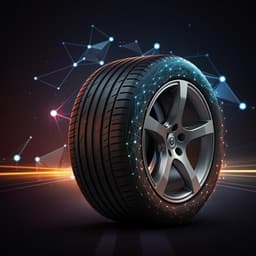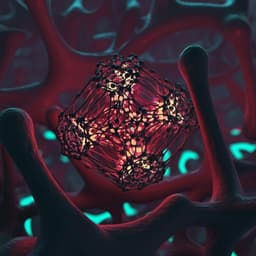
Environmental Studies and Forestry
3D printed Ti₃C₂@Polymer based artificial forest for autonomous water harvesting system
J. V. Vaghasiya, K. K. Sonigara, et al.
Discover how an innovative autonomous artificial forest can effectively harvest over 5.5 L m⁻² of freshwater daily. This research was conducted by Jayraj V. Vaghasiya, Keval K. Sonigara, Carmen C. Mayorga-Martinez, and Martin Pumera.
~3 min • Beginner • English
Introduction
Freshwater scarcity affects billions of people and requires sustainable technologies to secure clean water access. Two complementary strategies are solar vapor generation devices (SVGDs), which use sunlight to evaporate polluted or seawater, and fog harvesting devices (FHDs), which capture atmospheric moisture. Three-dimensional (3D) architectures generally outperform 2D designs for both evaporation and fog collection by providing larger interfacial areas, improved thermal management, and enhanced air convection. 3D printing offers design freedom, material diversity, rapid prototyping, and facile integration of multiple functions, making it attractive for water-harvesting systems. Despite advances, separating SVG and fog collection into distinct systems limits all-weather freshwater production. Some 3D hydrogel devices can operate day and night but rely on static architectures that require manual alignment changes for evaporation versus fog capture. This work addresses that gap by introducing environmental responsiveness into 3D-printed systems. The authors present an autonomous 3D artificial forest (3D AF) combining a CNF/PLA structure with a Ti₃C₂@PPy-coated evaporator foundation and an integrated photothermal actuator (shape memory alloy) to self-adjust orientation for day-night water harvesting. The device aims to maximize sunlight absorption and interfacial evaporation by day and optimize fog interception and droplet transport by night, enabling continuous freshwater production.
Literature Review
Prior studies show 3D-printed SVGDs achieve high evaporation by maximizing evaporation area over light-absorbing area and leveraging air convection. Numerous materials and designs, including MXene-based composites and hierarchical structures, have been developed to enhance light absorption, heat localization, and salt resistance. For FHDs, bioinspired designs emulate cacti, gunnera leaves, nepenthes, wheat awns, cotula fallax, shorebird beaks, Namib beetle bumps, and spider webs to create surfaces and architectures favorable for droplet nucleation and transport. While several 3D-printed fog collectors and bifunctional hydrogels exist, most systems are not programmable and require manual angle adjustment to switch between modes. Reported fog collectors can achieve high rates under controlled humidity, and some microstructured designs (e.g., spider webs, wheat awns, micro-tree arrays) outperform generic tree/spine shapes; however, they are typically single-function. MXene-based evaporators have shown strong solar-to-thermal performance, yet integration with autonomous alignment for all-day harvesting remains underexplored. This work targets a programmable, autonomous 3D-printed platform that merges high-efficiency MXene@polymer photothermal conversion with fog collection capability.
Methodology
Design and 3D printing: The artificial forest consists of two parts modeled in Fusion 360: a square foundation (3 × 3 cm², 2 mm thick) and tree arrays with varying branch numbers. Each branch is 5 mm long, 1 mm wide, and 15 mm high. Parts were printed on a Prusa i3 MK3S (direct-drive extruder) using CNF/PLA filament at 220 °C, 5 mm/s print speed, and 90% filament flow.
Surface activation and electrodeposition: To enable electrodeposition, surface PLA on the foundation was partially removed by immersing in 1 M NaOH for 3–4 h, followed by DI water rinse and drying at 40 °C. Approximately 6–8% PLA mass was removed, exposing a CNF network (fiber diameters ~50–80 nm). Ti₃C₂@PPy was electrodeposited from a bath containing pyrrole (0.3 M), Ti₃C₂ dispersion (3 mg mL⁻¹), and LiCl (1 mg). A cycling potential of 0–0.8 V (Autolab) was applied for 40 min using the 3D foundation as working electrode, Pt counter, and Ag/AgCl reference. The coating forms a porous, layered Ti₃C₂ with PPy matrix.
Assembly: The Ti₃C₂@PPy-coated foundation and untreated CNF/PLA trees were joined using a 3D pen and CNF/PLA filament.
Autonomous actuation: A Ti45%/Ni55% shape memory alloy (SMA) photothermal actuator with a flattened memorized shape was integrated with elastic rubber. One end was attached to the 3D AF (silicone glue) and the other to a support. Without light, the assembly rests at ~45°; under illumination, photothermal heating triggers SMA opening, flattening toward 0°; on cooling, elastic rubber provides a closing force to recover incline. A similar actuator was integrated with a plastic condensing roof to close by day and open by night.
Characterization: SEM/EDS characterized morphology and elemental distribution; XRD confirmed structures (PPy amorphous peak ~25.9°, Ti₃C₂ (002/(004)/(006)/(008)) layered features). UV–vis–NIR spectroscopy (200–2500 nm) assessed absorption; Ti₃C₂@PPy improved visible absorption by ~6.2% vs activated foundation and showed superior NIR absorption. IR thermography under 1 sun measured surface temperatures in dry and wet conditions.
Solar evaporation tests: A lab-made solar simulator (100 mW cm⁻²) illuminated the 3D AF floating on water. Small holes in the foundation ensured continuous water supply. Mass loss was recorded on an analytical balance (HR-100AZ). Surface temperatures were tracked via IR camera (Seek Thermal). Tests ran at ~21 °C and ~50% RH. Evaporation rate was computed as mass loss per illuminated area per time; efficiency used the reported enthalpy, optical concentration, and solar power.
Fog collection tests: Under ambient ~21 °C with 95% RH fog generated by a humidifier (Hysure Pro-4), fog impinged vertically on the 3D AF set at specified angles (0°, 15°, 45°). Collected water flowed to a reservoir and was weighed to calculate collection rate (mass gain per area per time). Designs with 1, 2, and 3 branches were evaluated; multi-cycle stability over 10 cycles was assessed.
Key Findings
- Ti₃C₂@PPy-coated 3D AF foundation exhibits broad UV–vis–NIR absorption; visible absorption improved by ~6.2% versus activated (NaOH-treated) foundation, with superior NIR absorption.
- IR thermography under 1 sun: 3D AF dry surface reached ~87 °C (activated foundation ~57 °C). In wet state, max surface temperature ~47 °C, indicating efficient heat transfer to water for evaporation.
- Surface hydrophilicity supports interfacial evaporation; as-printed tree water contact angle ~69.6° promotes fog droplet capture and transport.
- Solar vapor generation: water-only baseline ~0.45 kg m⁻² h⁻¹; activated foundation 1.24 kg m⁻² h⁻¹ (efficiency ~63%); Ti₃C₂@PPy 3D AF achieved 2.12 kg m⁻² h⁻¹ with reported efficiency ~108% under 1 sun (100 mW cm⁻²).
- Performance versus light intensity: 0.3 sun → 0.8 kg m⁻² h⁻¹; 0.5 sun → 1.02 kg m⁻² h⁻¹; 1.5 sun → 2.78 kg m⁻² h⁻¹.
- Durability under continuous 1 sun exposure: after 10 cycles (8 h each), evaporation rate decreased by ~6% (2.12 to 1.99 kg m⁻² h⁻¹).
- Fog collection optimization: three-branch trees collected more than one- or two-branch designs (average ~0.25 g cm⁻² h⁻¹ for three branches). Aligning the forest toward fog flow at 45° significantly enhanced fog collection to ~0.45 g cm⁻² h⁻¹.
- Fog collection stability: after ten cycles, efficiency remained above 93%.
- Autonomous operation: integrated SMA actuator tilted the 3D AF downward during light exposure for evaporation and restored an inclined angle in dark for fog capture; the condensing roof also self-adjusted. After 10 actuation cycles, angle variation was small (±2°), indicating stable elastic recovery.
- Outdoor, continuous day–night operation yielded ~5.5 L m⁻² of freshwater per day on average across seven days, with variations due to weather (temperature, humidity, light intensity).
Discussion
The study addresses the need for continuous, all-weather freshwater harvesting by integrating solar interfacial evaporation and fog collection into a single, programmable 3D-printed system. The Ti₃C₂@PPy composite provides synergistic light trapping (layered Ti₃C₂ reduces reflection and rapidly heats) and efficient heat distribution (PPy), enabling high evaporation rates under various solar intensities with minimal thermal loss to bulk water. The CNF/PLA tree architecture, with moderate hydrophilicity and groove-induced capillary pathways, promotes droplet nucleation and directed transport from branch tips to the foundation. Critically, the photothermal SMA actuator enables autonomous reconfiguration: the system flattens by day to maximize solar absorption and interfacial contact for evaporation, and inclines at night to align with fog flow for improved capture. This autonomous modality eliminates manual alignment, overcoming a key limitation of prior bifunctional or 3D-printed designs. Demonstrated outdoor performance (~5.5 L m⁻² day⁻¹) underscores the approach’s practical relevance and potential for scalable freshwater generation in variable climates.
Conclusion
This work demonstrates a programmable, 3D-printed artificial forest that autonomously alternates between daytime solar evaporation and nighttime fog harvesting. The Ti₃C₂@PPy-coated CNF/PLA foundation delivers high solar absorption and photothermal conversion, achieving 2.12 kg m⁻² h⁻¹ evaporation at 1 sun with strong durability. The optimized tree architecture (three branches) and 45° inclination maximize fog collection to 0.45 g cm⁻² h⁻¹, with stable multi-cycle performance. Integration of a shape memory alloy actuator and elastomer enables reliable day–night self-alignment, and outdoor tests confirm continuous water production averaging ~5.5 L m⁻² per day. Future work could focus on scaling the footprint and density of the forest, enhancing robustness under harsh environments (salt, biofouling, dust), optimizing microtexture and wettability gradients for higher fog capture, integrating energy capture or storage, and long-term field trials across diverse climates.
Limitations
- Trade-off between fog collection and solar evaporation: increasing branch number beyond three may boost fog capture but reduces solar heating due to shading, lowering evaporation performance (~1.85 kg m⁻² h⁻¹ observed with four branches).
- Fog collection benchmarks: while the tree-based design performs well, some specialized 3D-printed fog collectors (e.g., spider webs, wheat awns, micro-tree arrays) report higher fog capture rates under similar humidity, indicating room for architectural refinement.
- Testing scope: Durability was evaluated over 10 cycles for both evaporation and actuation; longer-term, real-world endurance (weeks to months), resistance to scaling/salt deposition, and mechanical wear were not reported.
- Environmental dependence: Outdoor daily yield (~5.5 L m⁻²) varied with weather (temperature, humidity, irradiance); performance in arid, low-humidity conditions and across seasons needs broader validation.
- Scale and integration: Demonstrations used small prototypes (foundation 3 × 3 cm²). System-level considerations (module interconnection, water management, structural stability in wind, maintenance) remain to be addressed for practical deployment.
Related Publications
Explore these studies to deepen your understanding of the subject.







